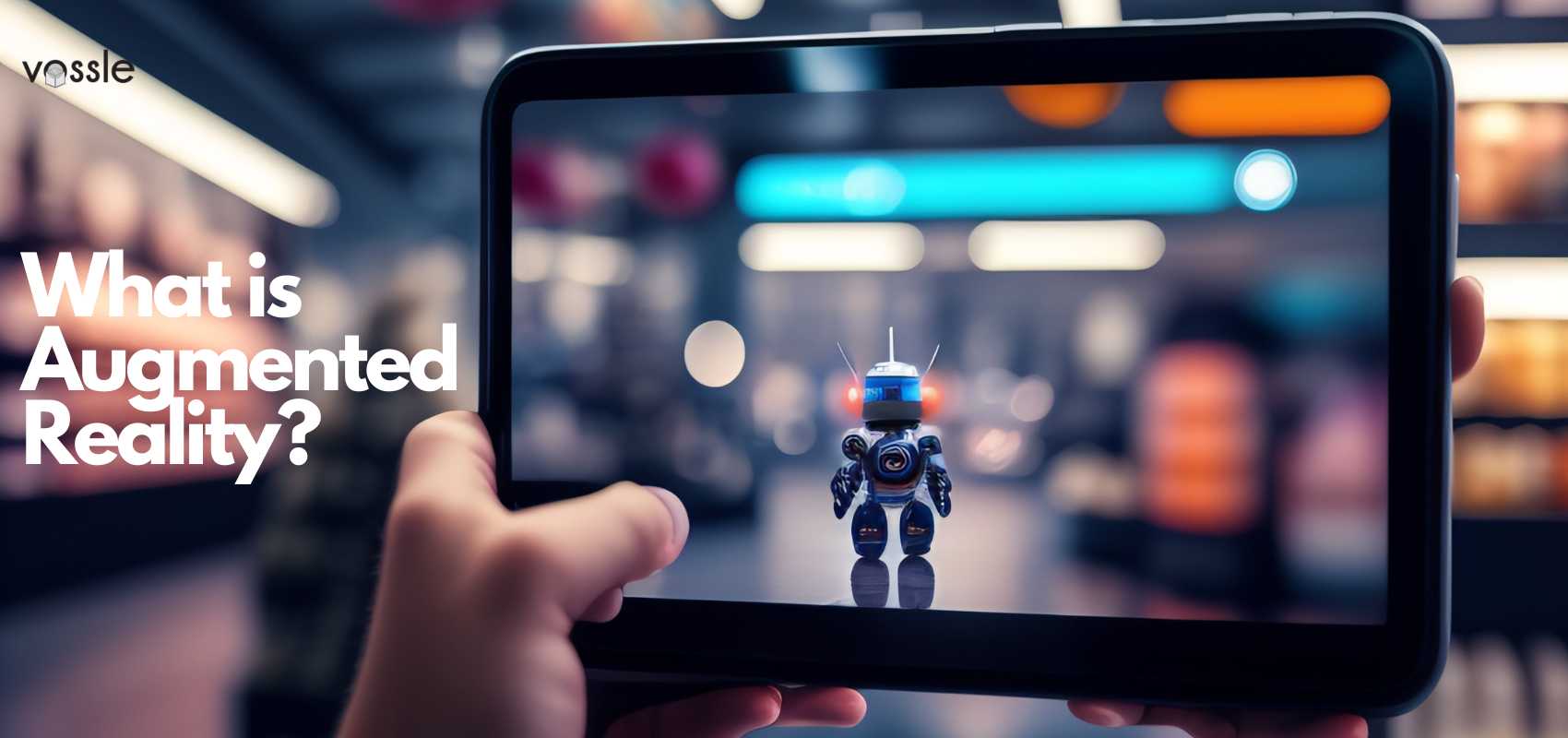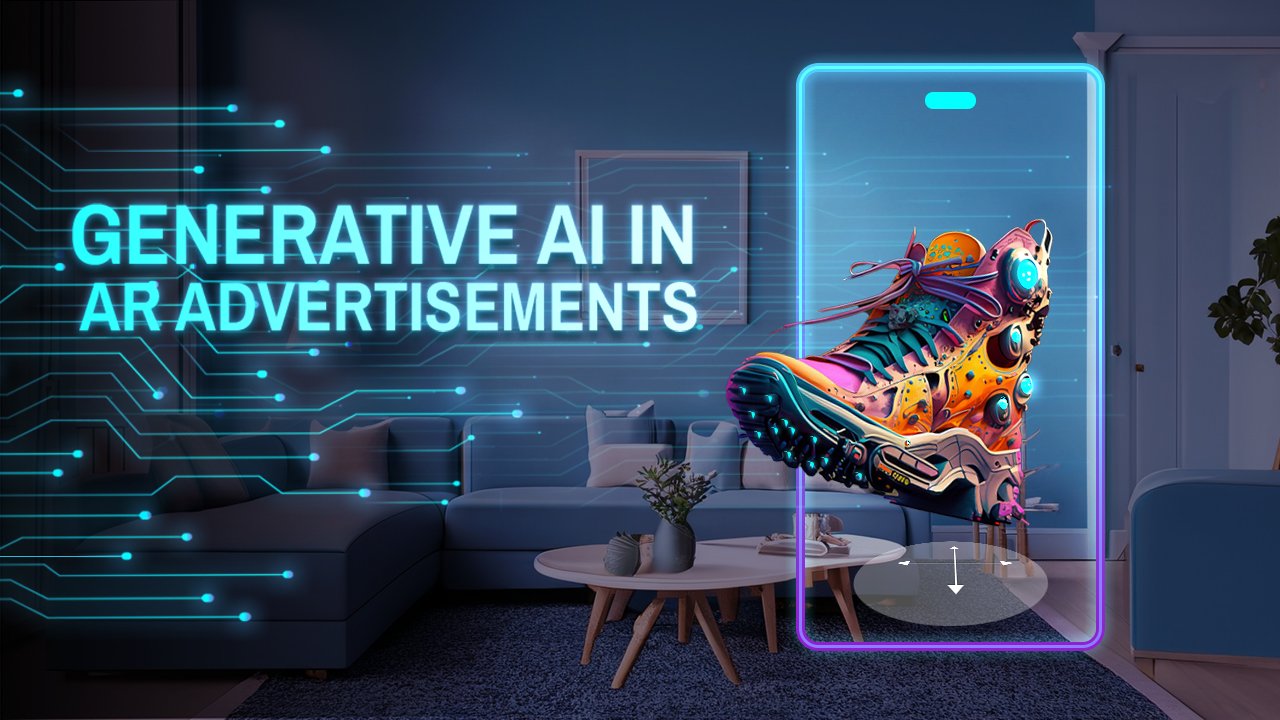Augmented Reality, or AR, is a cutting-edge technology that blends the virtual world with the real world by overlaying digital information onto our physical environment. Unlike Virtual Reality (VR), which immerses users in a completely computer-generated environment, AR enhances our perception of existing physical reality by adding digital elements to what we see and experience in real-time.
The roots of AR can be traced back to the 1960s when computer scientist Ivan Sutherland introduced the concept of a “head-mounted display” that could overlay simple wireframe graphics onto the user’s view.
Over the decades, AR technology has made significant advancements, thanks to breakthroughs in computer processing power, miniaturization of hardware, and the development of sophisticated tracking and mapping techniques.
And finally, the introduction of smartphones and wearable devices gave a big boost to the adoption and popularity of AR. AR entered the mainstream through gaming, entertainment, and its integration on popular social media platforms making AR one of the most important technologies of the time.
AR holds immense importance in transforming the way we interact with digital information and the world around us. Its potential applications are vast and span various industries. AR revolution is way beyond gaming and entertainment and projects potential for fields such as marketing, education, healthcare, architecture, manufacturing, and others.
By seamlessly integrating digital content into our physical environment, AR opens up new possibilities for enhanced visualization, interactive experiences, and improved productivity.
We present to you this comprehensive blog that discusses Augmented Reality in detail yet in simpler and more understandable terms. Reading this blog will help you understand immersive technology comprehensively and with clarity. So, let’s start.
How Augmented Reality Works: Unlocking the Secrets Behind AR Technology
At its core, AR relies on three main components: a display system, tracking technology, and content creation tools. The display system can range from smartphones and tablets to smart glasses and heads-up displays (HUDs). These devices act as windows through which digital content is overlaid in the real world.
Tracking technology, such as cameras, sensors, spatial computing, and GPS, enables AR systems to understand the user’s position and orientation in real-time.
Lastly, content creation tools empower developers to create and deploy digital content, including 3D models, animations, and interactive elements, that seamlessly integrate with the user’s surroundings.
To understand these core components better, we first need to understand two components that form the bases of the above three i.e. the hardware and software components.
Overview of Hardware and Software Used in AR Systems
The hardware and software components work together to bring AR experiences to life. While hardware like specialized headsets, smartphones, and AR glasses provide the much-needed and robust platform for the software to do its job and deliver mind-blowing experiences.
Software like AI-driven computer vision and machine learning, spatial computing, SLAM, rendering engines, and development platforms all work together to make the AR experience convincing and worth experiencing. Let’s see what the AR hardware does.
AR Hardware
When it comes to AR hardware, there is a wide array of options that offer diversity and excitement. Let’s start with the devices that have become an integral part of our lives – smartphones and tablets. These devices have evolved into essential companions, providing us with connectivity, productivity, and now, immersive AR experiences.
One of the remarkable features of smartphones and tablets is their built-in AR capabilities. They are equipped with advanced components that enable the delivery of impressive AR experiences. Let’s discuss these features in detail.
High-Resolution Displays
High-resolution displays play a vital role in showcasing virtual content with clarity and detail, ensuring a visually appealing and immersive experience. Whether it’s virtual objects overlaying the real world or interactive elements responding to user input, the quality of the display enhances the overall AR experience.
Camera
The powerful cameras integrated into smartphones and tablets contribute significantly to AR functionality. These cameras capture the real-world environment, allowing AR applications to precisely identify objects, surfaces, and markers.
With the help of AI-driven computer vision algorithms, the devices can analyze the camera feed in real-time, recognizing and tracking the position of objects and enabling the seamless integration of digital content into the user’s surroundings.
Sensors: Accelerometers and Gyroscopes
Sensors such as accelerometers and gyroscopes play a crucial role in producing high-quality AR experiences for smartphones and tablets. While a gyroscope senses change in the orientation of a device, an accelerometer measures the vibration or acceleration of motion of the device.
Combined together, these sensors provide precise motion tracking, detecting the device’s orientation and movement in the 3D space. Hence, as the user moves their device in the physical space, the sensors detect the changes and translate them into corresponding movements within the AR application, specifically the overlaid 3D digital object.
This tracking capability ensures that virtual objects remain aligned with the real-world environment and merge with it seamlessly, thereby, creating a convincing, immersive, and unforgettable AR experience.
Specialized Headsets and AR Glasses
Further, apart from smartphones and tablets, specialized AR headsets and AR glasses offer an extraordinary experience for those seeking a heightened level of immersion,. Devices like Microsoft HoloLens, Google Glass, and the recently unveiled Apple Vision Pro bring AR to a whole new level.
Talking about the headsets boast advanced optics, transparent displays, and sensors that meticulously track your movements. With such headsets, you can enjoy a hands-free experience while seamlessly interacting with digital content that seamlessly blends into the real world.
On the other hand, let’s not overlook the remarkable AR glasses! Designed to be lightweight and comfortable, futuristic devices provide an exceptional AR encounter. By overlaying digital information onto your field of view, these glasses create the illusion that the virtual world is right in front of you.
To ensure an accurate and seamless AR experience, these glasses also feature cameras and sensors that map your surroundings and keep track of users’ location.
Whether you opt for the convenience of smartphones and tablets, the immersive experience of specialized headsets, or the futuristic allure of AR glasses, the range of AR hardware available is designed to elevate your AR adventures and unlock new dimensions of possibility.
Now, let’s move on to the software part.
AR Software
When it comes to the software aspect of augmented reality, it’s a realm of highly intelligent algorithms and techniques that work their magic to captivate users. Let’s discuss each aspect one at a time.
AI and Machine Learning
Artificial Intelligence and Machine Learning play a pivotal role in AR software, and their impact cannot be overstated. These technologies are at the forefront of enhancing various aspects of AR experiences, including object recognition, tracking accuracy, and scene understanding.

Object Recognition is a fundamental capability in AR, enabling devices to identify and understand the objects and elements present in the real-world environment. Machine learning algorithms are employed to train models that can recognize and classify different objects, such as furniture, landmarks, or everyday items.
By leveraging vast amounts of data, these algorithms learn to identify objects accurately and quickly, enabling AR devices to overlay relevant digital content onto the recognized objects seamlessly.
Tracking accuracy is crucial for maintaining a consistent and realistic AR experience. AR devices need to accurately track the position and movement of the user and the surrounding environment to ensure that virtual objects align properly with the real world.
Machine learning and AI techniques are employed to improve tracking algorithms, enabling more robust and precise tracking capabilities. These algorithms learn from different scenarios and adapt to various environmental conditions, resulting in enhanced tracking accuracy and stability.
Scene understanding is another critical aspect where machine learning and AI excel in AR. By analyzing the scene and its elements, such as depth, lighting, and spatial relationships, AR devices can better understand the context in which virtual objects are placed.
This understanding allows for more realistic and context-aware integration of digital content into the real world. Machine learning models can be trained to interpret the scene and make informed decisions about how virtual objects should behave or interact with the environment. Thereby, improving the AR experience over time.
By leveraging machine learning techniques, AR devices can adapt to different lighting conditions, object variations, and user interactions, resulting in a more refined and personalized AR experience for users.
SLAM Algorithm
Achieving accuracy in AR experiences is made possible through simultaneous localization and mapping (SLAM) algorithms. These clever algorithms serve as the secret sauce in determining your exact position and orientation within your environment.
By creating a map of your surroundings and continually tracking your movements, SLAM algorithms anchor virtual objects in the right places, ensuring seamless integration between the virtual and real-world elements.
Rendering Engines
To make everything visually stunning, rendering engines take center stage. These powerful engines handle the real-time rendering of virtual content, ensuring it looks realistic and aligns perfectly with your perspective.
They take care of intricate details such as lighting, shading, and transparency, seamlessly blending virtual objects with the real world. By leveraging advanced rendering techniques, AR software creates an immersive and visually captivating experience for users.
Software Development Kits(SDKs)
And of course, we can’t forget the awesome development platforms and SDKs that make it all possible. Apple’s ARKit, Google’s ARCore, and Unity3D’s AR Foundation are examples of tools that developers use to create AR experiences for different hardware platforms. These platforms provide developers with the necessary tools and resources to bring their AR ideas to life.
AR Tracking and Mapping Techniques
Tracking and mapping techniques play a fundamental role in the seamless integration of digital content into the real world within AR systems. These techniques enable AR applications to accurately position and track virtual objects, enhancing the overall user experience. Let’s delve into the details of these techniques.

Marker-based tracking is a widely used approach in AR. It relies on predefined visual markers, such as QR codes or fiducial markers, which act as reference points in the real world. By recognizing and tracking these markers, AR systems can anchor digital content precisely onto them.
When the camera detects a marker in the user’s environment, the AR software aligns the virtual object based on the marker’s position and orientation, creating the illusion of it being part of the physical world. Marker-based tracking is popular due to its simplicity and robustness, making it suitable for various AR applications.

In contrast, Markerless Tracking leverages advanced computer vision algorithms to track features and objects in the user’s environment without the need for predefined markers. This technique analyzes the visual data captured by the device’s camera, identifying distinct features, patterns, or objects in the surroundings.
By continuously tracking and matching these features over time, AR systems can accurately determine the device’s position and orientation relative to the environment. Markerless tracking offers more flexibility as it doesn’t require specific markers, allowing for a more natural and spontaneous AR experience.
Simultaneous Localization and Mapping (SLAM) is a powerful technique that combines mapping the physical environment with real-time tracking of the user’s position and movements. In SLAM, AR systems create a map of the environment by collecting and analyzing data from various sensors, such as cameras and motion sensors.
This map includes information about the physical structure, objects, and features of the surroundings. Simultaneously, SLAM algorithms track the user’s position and movements within this mapped environment. By continuously updating the map and the user’s position, AR systems can accurately place and align virtual objects in the real world.
SLAM is commonly employed in AR applications on mobile devices, as it allows for real-time tracking and mapping without relying on external infrastructure.
These tracking and mapping techniques are essential components of AR systems, enabling precise positioning and alignment of virtual content within the user’s environment. Whether using markers or advanced computer vision algorithms or employing SLAM for simultaneous mapping and tracking, these techniques contribute to the immersive and realistic nature of AR experiences. By seamlessly blending digital content with the real world, AR applications can create engaging and interactive experiences that bridge the gap between the physical and virtual realms
Popular AR Platforms and Devices
Several popular AR platforms and devices have emerged, transforming and contributing to the development of Augmented Reality technology. Let’s take a closer look at some notable platforms and devices that have gained significant traction in recent years.
Powerful Development Platforms
Apple’s ARKit and Google’s ARCore are two powerful software development kits (SDKs) that have revolutionized AR app development. ARKit provides a comprehensive framework for creating AR experiences on iOS devices, while ARCore offers similar capabilities for Android devices.
These SDKs provide developers with tools, libraries, and APIs to easily integrate AR features into their applications. By leveraging the capabilities of these SDKs, developers can create compelling and immersive AR applications for a broad range of mobile devices.
No-code, AI-automated AR Platform
Notably, there is also Vossle, an AI-powered cloud-based SAAS platform that allows its users to create AR experiences without writing a single line of code. This means anyone who knows how to run a computer can create an AR experience using Vossle. Sounds unbelievable, believe it.
All you need to do is just register on Vossle, upload 3D models, use its generative AI feature to produce unique and copyright-free images, upload the 3D models and images, adjust settings and that’s it.
Social AR Platform
In social media, Snapchat and Instagram have introduced AR filters and effects that have captivated millions of users worldwide. These platforms have popularized the use of AR in everyday communication and self-expression.
With Snapchat’s AR lenses and Instagram’s face filters, users can apply virtual masks, effects, and animations to their selfies and videos, adding a touch of fun and creativity to their social media posts.
Popular AR Headsets
Moving to hardware, the recently launched Apple Vision Pro, alongside Microsoft’s HoloLens and devices like Oculus Quest, has emerged as a game-changer in the AR space.
Microsoft HoloLens
Microsoft’s HoloLens is an advanced mixed-reality headset that seamlessly blends virtual content with the real world. It incorporates spatial mapping and tracking technologies, allowing users to interact with holograms and digital objects in their physical surroundings. HoloLens finds applications in various fields such as industrial design, architecture, gaming, and entertainment.
Oculus Quest VR
Similarly, the Oculus Quest VR headset, primarily known for virtual reality, also features AR capabilities. It utilizes passthrough technology, enabling users to see and interact with their real-world environment while wearing the headset.
This passthrough mode facilitates limited AR experiences by overlaying virtual objects onto the user’s surroundings. With its untethered design and powerful tracking capabilities, the Oculus Quest delivers immersive and interactive AR experiences.
Apple Vision Pro
In this context, Apple Vision Pro deserves recognition for its transformative impact on the AR landscape. Integrated into Apple devices, Apple Vision Pro leverages advanced computer vision and machine learning capabilities. It enables devices to understand and interpret the physical environment, recognize objects, and accurately position virtual content within that space. The integration of Apple Vision Pro has elevated the realism and integration of AR content, offering users a more immersive and intuitive experience.
Together, these platforms and devices, including Apple Vision Pro, Microsoft’s HoloLens, and Oculus Quest, have played a significant role in popularizing AR. They have made AR more accessible and engaging for users across industries.
Additionally, the support of powerful software platforms like Vossle, ARKit and ARCore, as well as the presence of AR features on social media platforms like Snapchat and Instagram, have further contributed to the integration and widespread adoption of AR.
The combined efforts of these advancements continue to shape the way we interact with the digital world, offering exciting possibilities for the future of augmented reality.
Key Features and Benefits of Augmented Reality
Augmented Reality (AR) is a technology that offers numerous features and benefits, transforming the way we perceive and interact with the world around us.
Enhanced Visualization and Immersion:

AR overlays digital content onto the physical environment, providing an immersive experience that enhances our visualization of the world. By seamlessly blending virtual objects with reality, AR enables us to gain deeper insights, visualize complex data, and explore new perspectives. This feature has applications in various fields, from architecture and design to scientific research and data analysis.
Real-time Interaction and Information Overlay:
AR allows for real-time interaction and manipulation of virtual content overlaid in the real world. Users can engage with virtual buttons, menus, and gestures, enabling intuitive and dynamic interactions.
Moreover, AR can provide contextual information overlay, such as displaying directions, product details, or historical facts, enriching our understanding and enhancing decision-making processes.
This feature enhances our daily activities, whether it’s navigating through unfamiliar places or accessing real-time information on the go.
Improved User Experience and Engagement:
AR has the potential to revolutionize user experiences across various industries. In gaming, AR games like Pokémon Go have captivated millions of players worldwide by merging the virtual and real worlds, creating unique and immersive gameplay.
In retail, AR enables customers to virtually try on clothes or visualize furniture in their homes before making a purchase, enhancing engagement and personalization. By creating memorable and interactive experiences, AR leaves a lasting impact on users.
Potential for Educational and Training Applications:
AR holds tremendous potential in the field of education and training. By bringing static concepts to life and making abstract ideas tangible, AR enhances learning experiences. Students can explore virtual models of historical landmarks, dissect 3D anatomy, or engage in interactive simulations, promoting a deeper understanding of complex subjects.
In professional training, AR can provide step-by-step guidance, overlay instructional content, and offer real-time feedback, improving the effectiveness and efficiency of training programs.
Enhanced Productivity and Efficiency in Various Industries:
AR has proven to be a game-changer across industries such as manufacturing, healthcare, and maintenance. By overlaying relevant information and instructions onto physical objects, AR helps workers perform complex tasks with greater accuracy and speed.
AR-assisted maintenance procedures can reduce downtime by providing real-time guidance, while AR-guided medical procedures can enhance precision and minimize risks. The hands-free nature of AR devices also allows workers to access critical information without disrupting their workflow, increasing productivity.
Overall, the key features and benefits of AR, including enhanced visualization, real-time interaction, improved user experiences, educational applications, and enhanced productivity, make it a transformative technology with immense potential to shape numerous industries and enhance our daily lives.
Applications of Augmented Reality
Augmented Reality (AR) has emerged as a transformative technology with a wide range of applications across various industries. From gaming and entertainment to marketing, education, healthcare, architecture, and manufacturing, AR is revolutionizing how we interact with the digital world and enhancing our real-world experiences.
AR in Gaming and Entertainment:
The gaming industry has witnessed a seismic shift with the introduction of AR. Games like Pokémon Go, Harry Potter: Wizards Unite and Minecraft Earth have captivated millions of players by seamlessly blending virtual characters and worlds with our real environment.
AR gaming encourages exploration, social interaction, and a sense of immersion like never before. Moreover, AR is being leveraged in live events and concerts to overlay digital effects, augment performances, and create unforgettable experiences for attendees.
AR in Marketing and Advertising:
AR has opened up new dimensions in marketing and advertising strategies. Brands now have the ability to create engaging and interactive campaigns that capture consumers’ attention and leave a lasting impact.
AR-powered try-on experiences for cosmetics, virtual showrooms for fashion brands, and interactive product demonstrations are just a few examples of how AR is transforming the marketing landscape. By integrating AR into their campaigns, brands can forge deeper connections with their target audience and drive increased customer engagement.
AR in Retail and e-Commerce:
AR is reshaping the retail and e-commerce industry by bridging the gap between online and offline shopping experiences. With AR, customers can now visualize products in their own space before making a purchase, eliminating the guesswork and enhancing confidence.
Virtual try-on for clothing and accessories, furniture placement visualization, and virtual home tours are some of the powerful AR applications in the retail sector. By enabling customers to interact with products virtually, AR is revolutionizing the way people shop and enhancing their overall shopping experience.
AR in Education and Training:
AR has immense potential to revolutionize education and training. By offering interactive and immersive experiences, AR can transform the way students learn and engage with educational content.
Virtual field trips to historical sites, interactive science simulations, and language learning applications are just a few examples of how AR is reshaping traditional educational approaches. By bringing abstract concepts to life and making learning more engaging, AR has the power to enhance retention and understanding among students.
AR in Healthcare and Medicine:
The healthcare industry is benefiting from the advancements in AR technology. Surgeons can utilize AR overlays to visualize medical imaging during procedures, improving accuracy and precision.
Medical training programs leverage AR to simulate surgeries and provide a hands-on learning experience for aspiring healthcare professionals. AR also plays a vital role in patient education by visualizing complex medical conditions and treatment plans, enabling patients to have a better understanding of their health.
AR in Architecture and Design:
AR has become an invaluable tool for architects and designers. By overlaying virtual models onto physical spaces, AR allows architects to visualize their designs in real-world contexts. This capability helps assess spatial relationships, lighting conditions, and aesthetics more effectively.
Clients can experience virtual walkthroughs of architectural projects, enabling them to provide feedback and make informed decisions. AR enhances the design and construction process, resulting in improved outcomes and client satisfaction.
AR in Manufacturing and Maintenance:
AR is streamlining manufacturing and maintenance processes by providing real-time guidance and instructions. Assembly line workers can receive overlayed instructions directly on their workstations, reducing errors and increasing efficiency.
AR-guided maintenance procedures provide technicians with step-by-step instructions, minimizing downtime and improving equipment reliability. By leveraging AR, manufacturers can enhance productivity, streamline operations, and ensure consistent quality in their processes.
Hence, the applications of AR span across a multitude of industries, reshaping the way we interact with technology, improving user experiences, and unlocking new possibilities for innovation. AR continues to evolve and has the potential to transform various sectors, empowering businesses and individuals to achieve new levels of productivity, creativity, and engagement.
Challenges and Limitations of Augmented Reality
While Augmented Reality (AR) holds immense potential, there are several challenges and limitations that need to be addressed for its widespread adoption and optimal usage.
Hardware Limitations and Cost:
AR hardware still faces limitations in terms of size, weight, battery life, and field of view. High-quality AR experiences often require expensive devices, which can limit accessibility for some users.
However, as technology continues to advance, we can expect improvements in hardware capabilities, including smaller and more lightweight devices with extended battery life, as well as more affordable options that cater to a broader user base.
User Interface and Interaction Challenges:
Designing intuitive and seamless user interfaces for AR can be a complex task. AR applications must provide clear instructions and easy-to-understand interactions to ensure a smooth and engaging user experience.
Striking the right balance between presenting virtual content and maintaining awareness of the user’s real-world surroundings is crucial to prevent information overload or visual clutter. Designers and developers need to invest in user-centric design approaches to overcome these challenges and create user-friendly AR experiences.
Privacy and Security Concerns:
AR relies on collecting and processing real-time data from the user’s environment, including personal information, location data, and visual recordings. This raises privacy and security concerns.
It is essential to establish robust privacy policies, implement secure data encryption techniques, and obtain informed consent from users to address these concerns and protect their privacy. Developers and organizations must prioritize user data protection and ensure transparent practices to build trust among users.
Ethical Considerations and Potential Misuse:
As with any powerful technology, AR raises ethical considerations. There is a need for responsible and ethical use to prevent misuse or harm. AR applications should adhere to ethical guidelines regarding content creation, user safety, and potential societal implications.
This includes avoiding the creation or dissemination of harmful or offensive content and ensuring that AR experiences do not infringe upon individual rights or contribute to negative social consequences. Ongoing discussions and collaborations between developers, researchers, and policymakers are essential in addressing these ethical concerns proactively.
Technical Challenges in AR Development and Implementation:
Developing high-quality AR experiences requires overcoming technical challenges. This includes accurate tracking and mapping of the user’s environment, real-time rendering of complex 3D content, and seamless integration with different hardware and operating systems. Additionally, ensuring compatibility and optimization across a range of devices and platforms presents further technical hurdles.
Continued advancements in computer vision, graphics processing, and software development frameworks will play a crucial role in overcoming these challenges and enabling the creation of compelling and robust AR applications.
Overall, while AR offers exciting possibilities, addressing these challenges and limitations is essential for its continued growth and adoption. By investing in research, technological advancements, user-centered design, privacy protection measures, and ethical considerations, we can unlock the full potential of AR and ensure its responsible and beneficial use across various industries and domains.
Future Trends and Developments in Augmented Reality
The future of Augmented Reality (AR) holds exciting possibilities, with several key trends and developments on the horizon. These advancements will shape the way we interact with AR and unlock new opportunities across various industries.
Hardware Advancements:
In the coming years, we can anticipate significant improvements in AR hardware. Lighter, more comfortable, and more affordable AR devices will emerge, offering users a more enjoyable and immersive experience.
These devices will feature expanded fields of view, longer battery life, and improved display quality. Advancements in miniaturization, optics, and sensor technologies will contribute to the development of sleeker and more convenient AR devices.
Integration with Emerging Technologies:
AR’s potential will be further realized through integration with other emerging technologies. Artificial Intelligence (AI) will play a crucial role in enhancing AR experiences. AI-powered algorithms will improve object recognition and tracking, enabling more robust and accurate AR overlays.
The Internet of Things (IoT) will also play a significant role by connecting AR applications with real-time data and contextual information. This integration will create dynamic and personalized AR experiences, opening up new avenues for innovation.
Expanded Applications across Industries:
As Augmented Reality technology matures, its adoption will expand across various industries. We can expect to see innovative AR applications in tourism, sports, transportation, healthcare, and entertainment, among others. AR will transform how we explore new destinations, providing interactive and informative experiences.
In the sports industry, AR can enhance live broadcasts and offer fans immersive viewing experiences. AR will revolutionize transportation by providing real-time navigation and contextual information.
Furthermore, AR will continue to have a significant impact on healthcare, from assisting in surgical procedures to enhancing patient care and education. In the entertainment industry, AR will push the boundaries of immersive storytelling and gaming experiences.
Impact of 5G Networks on Augmented Reality:
The rollout of 5G networks will be a catalyst for the widespread adoption of AR. The increased network speeds, lower latency, and higher capacity of 5G will enable seamless streaming of high-quality AR content.
This will facilitate real-time interactions, collaborative AR experiences, and cloud-based AR applications. 5G networks will provide the foundation for AR to reach its full potential, transforming how we consume and interact with AR content.
Speculations on the Future of AR and Societal Implications:
Looking ahead, AR has the potential to reshape our daily lives and society as a whole. It may redefine how we communicate, learn, work, and interact with our environment. As AR becomes more prevalent, discussions on ethical, cultural, and social implications will become increasingly important.
Ensuring responsible and inclusive integration of AR into our society will be crucial. These discussions will cover topics such as privacy, security, accessibility, and the impact of AR on human interactions and social dynamics.
The future of AR is bright, with advancements in hardware, integration with emerging technologies, expanded applications across industries, the impact of 5G networks, and societal implications shaping its trajectory.
By embracing these developments and addressing associated challenges, we can harness the full potential of AR to enhance our lives and drive innovation in countless domains.
Conclusion
In conclusion, augmented reality (AR) stands as a transformative technology that seamlessly merges the virtual and real worlds, ushering in a new era of possibilities across various industries. With its ability to enhance visualization, enable real-time interaction, and elevate user experiences, AR holds immense potential for innovation and growth.
As we look ahead, there are challenges that need to be addressed to fully unlock the potential of AR. Technical hurdles, such as improving tracking accuracy and enhancing the realism of virtual content, continue to be areas of active research and development. Additionally, considerations around user privacy, data security, and ethical use of AR technology are of paramount importance.
Despite these challenges, ongoing advancements in AR hardware, software, and algorithms are paving the way for a promising future. As technology evolves, we can expect more sophisticated AR experiences with improved accuracy, realism, and ease of use. Furthermore, the integration of other emerging technologies like artificial intelligence, machine learning, and spatial computing will further augment the capabilities and impact of AR.
To ensure the responsible and ethical use of Augmented Reality, it is vital for industry stakeholders, policymakers, and users to collaborate and establish guidelines and standards. This includes prioritizing user privacy, data protection, and security measures to build trust and confidence in AR applications. Moreover, fostering inclusivity and accessibility in the design and implementation of AR solutions is crucial to ensure that this technology benefits people from all walks of life.
As we embrace this technological revolution, augmented reality is poised to reshape our world in ways we have never imagined. From revolutionizing education and training to transforming entertainment, gaming, and healthcare, AR offers exciting avenues for learning, playing, working, and connecting. It empowers us to visualize information in new dimensions, collaborate remotely, and bridge geographical barriers.



















